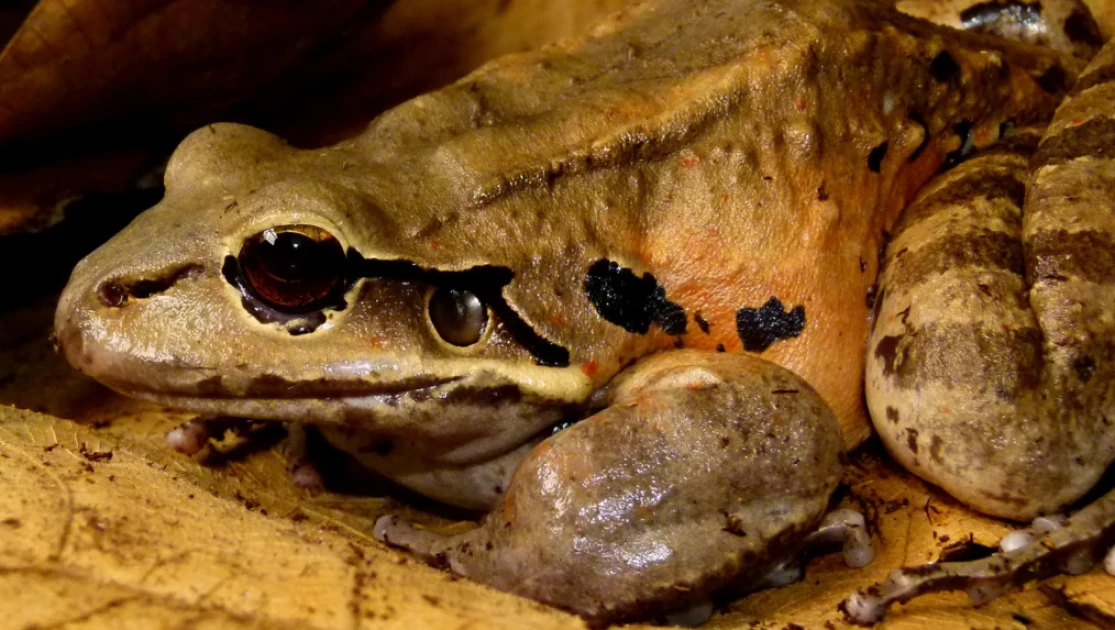An island frog became a national delicacy. Now there are only 21 left in the wild, scientists say

Once abundant in the Caribbean, only 21 mountain chicken frogs were found remaining in the wild, according to a new survey. The species is one of the largest frogs in the world.
The survey was conducted over 26 nights by a research team with the Mountain Chicken Recovery Programme, a project made up of 10 European and Caribbean conservation institutes with a goal to see healthy populations of the frog back in Dominica and Montserrat by 2034.
The research team spent hundreds of hours searching for the chicken frog during the months of July and August. The survey found 23 frogs, but two of those were dead on the road, said Andrés Valenzuela Sánchez, a research fellow in wildlife health with ZSL who was involved with the survey.
The international collaboration on the survey and efforts to save the mountain chicken frogs were inspiring for Sánchez. “But at the end, as we found so few animals, it was kind of sad as well. … The situation of the species in nature is even worse than what we thought before the survey.”
Frog considered critically endangered
Otherwise known as the giant ditch frog, the amphibian is one of the largest frogs in the world, weighing in at over 2 pounds (almost 1 kilogram) with a length of up to 8 inches. At night, the male’s reedy croaks used to reverberate throughout the rainforests and could be heard from more than 200 meters (656 feet) away, Sánchez said.
“We want to bring this sound back to our island, for our people,” Dominica ecologist Jeanelle Brisbane said in the ZSL news release. “It’s devastating that future generations may never hear this iconic soundscape which defines our island.”
After the spread of the deadly disease in 2002, the frog was classified as critically endangered with the Red List, Sánchez said, but it has faced threats for even longer than that, particularly from hunting — due to humans and other predators such as cats — as well as environmental issues.
“Sadly, we’re finding the frogs closer and closer to busy roads as they search for water, due to our rivers being so dry due to the changing climate in Dominica,” Brisbane said in the release.
Efforts to conserve the frogs
Chytrid disease has caused 90 extinctions of species within the past 50 years, according to the Smithsonian’s National Zoo & Conservation Biology Institute. Currently, no vaccine exists, but there is hope, said Alyssa Wetterau Kaganer, a postdoctoral associate with the Cornell Wildlife Health Lab who studies the disease. She was not involved with the survey.
“There is innovative research going on all around the world as stellar scientists explore different frog immunity, genetics, microbiome, and environmental treatment options,” Kaganer said via email.
A female Fender's blue butterfly. The species was reclassified from "endangered" to "threatened" by the US Fish and Wildlife Service.
This butterfly was once thought extinct. Now it’s off the endangered species list
“Moreover, the frogs themselves provide hope for a bright future; even species that have been particularly hard-hit by chytrid like the mountain chicken frog have individual animals that survive long periods of time in landscapes where the fungus is found — these individuals may provide the key to understanding how to best fight the fungus.”
The research team was discouraged to find the devastatingly low number of frogs in Dominica — it had expected to find at least 50, Sánchez said. A captive breeding program across several institutions, including London Zoo, a ZSL conservation zoo, featured an initial 50 frogs that now have offspring, Sánchez said.
During the survey, the team with ZSL took mouth swabs of the resident frogs found in Dominica and plan to study these for any evidence of the remaining frogs developing resistance to the fungus.
How to help the frogs
Some frogs are better equipped against the disease than others, Kaganer said. Certain frog species, such as the American bullfrog, according to the Amphibian Ark organization, have immune defenses that are fully tolerant of the disease, and others live in environments that the fungus has a hard time growing in, Kaganer said.
An emerald glass frog (Espadarana prosoblepon) in the Chuchanti reserve, in Darien, Panama, 28 March 2023 (issued 05 April 2023). In the reserve area there are more than 40 camera traps, twenty in the canopy - the layer of branches and leaves formed by the tops of neighboring trees - and the others in the understory - the variety of vegetation that grows in the areas closest to the floor-. The idea is to collect data that allows understanding "the dynamics" of this neotropical forest.
Often, the chytrid fungus is spread by human activity, Kaganer said, such as transporting infected animals or disposing of animal products or waste into the environment. It can even be spread through the tread in footwear.
“There are many things that people can do to prevent the spread of chytrid and help protect frogs,” Kaganer said in an email. “One great option is by taking care to clean footwear after spending time outdoors; take a minute to scrub all the mud out of your boot treads before you head home. … Just make sure to safely dispose of the waste!”
Financially supporting or volunteering with local conservation institutions and other organizations that prioritize biosecurity — measures that aim to prevent the spread of harmful diseases to animals in the wild — can also be crucial to conserving this frog species and others, Kaganer said.
Want to send us a story? SMS to 25170 or WhatsApp 0743570000 or Submit on Citizen Digital or email wananchi@royalmedia.co.ke
Comments
No comments yet.


Leave a Comment